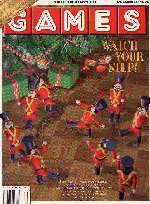THE GAME OF Y
Players: 2 Playing time: 20 minutes
Some two decades after its current rules were perfected, this intriguing game of skill has finally become available commercially. Its hardwood board, glass go stones, and fabric carrying pouches make it a handsome addition to any collection. Best of all, it's a game you will never tire of playing.
Though Y has great depth, it's hard to imagine simpler rules. Players take turns placing one stone of their color on any of the board's 93 intersections. Stones are never moved or captured. The player who links all three of the board's edges with an unbroken chain of stones of his color — a "Y" — is the winner. Corner points belong to both edges that meet there. Draws are impossible; blocking all ways for your opponent to form a Y necessarily means that you will form one yourself.
To balance the chances between players of greatly different strengths, or between adults and children, one player may start with two or more consecutive moves. Between equal, experienced players, using the "pie rule" — one player places the first stone, and the opponent either accepts it as his own or takes the other color — forces the first stone to be placed less than optimally and equalizes the chances very nicely.
An early version of the game, played on a triangular array of regular hexagons, was invented about 40 years ago by Charles Titus and Craige Schensted. But both it and the game of Hex, on which it was based, had a problem: Plays near the center were so powerful that the edge areas were largely irrelevant. Around 1970, the inventors added three interior points that border only five other points each instead of six. This subtle change not only caused the edges of the board to curve but also made the entire board important, greatly enriching the game's strategy and tactics.
The principles of the game, along with rules for several variations and the related game of Poly Y, were explored in the outstanding book Mudcrack Y and Poly Y (Neo Press, 1975), which is out of print. The section of it devoted to the Game of Y is being revised by Schensted and will be mailed to purchasers of the game when it is available. —R. Wayne Schmittberger





